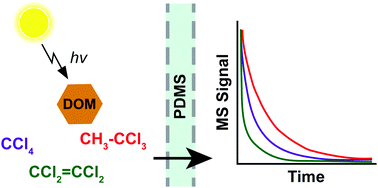Photosensitized degradation kinetics of trace halogenated contaminants in natural waters using membrane introduction mass spectrometry as an in situ reaction monitor
Abstract
The photochemically mediated dechlorination of polyhalogenated compounds represents a potential decontamination strategy and a relevant environmental process in chemically reducing media. We report the UV irradiation of natural and artificial waters containing natural dissolved organic matter to effect the photo-sensitized degradation of chlorinated organic compounds, including tetrachloromethane, 1,1,1-tricloroethane, perchloroethene, 1,2-dibromo-3-chloropropane and chlorobenzene at trace (ppb) levels in aqueous solution. The degradation kinetics are followed in situ using membrane introduction mass spectrometry. By re-circulating the reaction mixture in a closed loop configuration over a semi-permeable hollow fiber polydimethylsiloxane membrane in a flow cell interface, volatile and semi-volatile compounds are continuously monitored using a quadrupole ion trap mass spectrometer. The time resolved quantitative information provides useful mechanistic insights, including kinetic data. Pseudo first-order rate constants for the degradation of contaminant mixtures in natural waters are reported.


 Please wait while we load your content...
Please wait while we load your content...